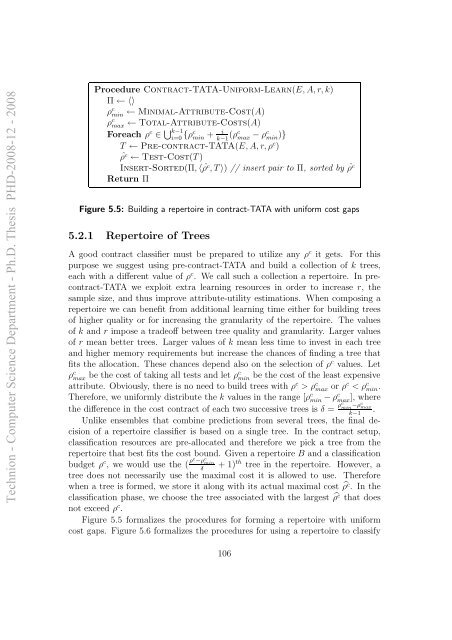anytime algorithms for learning anytime classifiers saher ... - Technion
anytime algorithms for learning anytime classifiers saher ... - Technion
anytime algorithms for learning anytime classifiers saher ... - Technion
You also want an ePaper? Increase the reach of your titles
YUMPU automatically turns print PDFs into web optimized ePapers that Google loves.
<strong>Technion</strong> - Computer Science Department - Ph.D. Thesis PHD-2008-12 - 2008<br />
Procedure Contract-TATA-Uni<strong>for</strong>m-Learn(E, A, r, k)<br />
Π ← 〈〉<br />
ρc min ← Minimal-Attribute-Cost(A)<br />
ρc max ← Total-Attribute-Costs(A)<br />
Foreach ρc ∈ �k−1 i=0 {ρc i<br />
min + k−1 (ρcmax − ρc min )}<br />
T ← Pre-contract-TATA(E, A, r, ρc )<br />
ˆρ c ← Test-Cost(T)<br />
Insert-Sorted(Π, 〈 ˆρ c , T 〉) // insert pair to Π, sorted by ˆρ c<br />
Return Π<br />
Figure 5.5: Building a repertoire in contract-TATA with uni<strong>for</strong>m cost gaps<br />
5.2.1 Repertoire of Trees<br />
A good contract classifier must be prepared to utilize any ρc it gets. For this<br />
purpose we suggest using pre-contract-TATA and build a collection of k trees,<br />
each with a different value of ρc . We call such a collection a repertoire. In precontract-TATA<br />
we exploit extra <strong>learning</strong> resources in order to increase r, the<br />
sample size, and thus improve attribute-utility estimations. When composing a<br />
repertoire we can benefit from additional <strong>learning</strong> time either <strong>for</strong> building trees<br />
of higher quality or <strong>for</strong> increasing the granularity of the repertoire. The values<br />
of k and r impose a tradeoff between tree quality and granularity. Larger values<br />
of r mean better trees. Larger values of k mean less time to invest in each tree<br />
and higher memory requirements but increase the chances of finding a tree that<br />
fits the allocation. These chances depend also on the selection of ρc values. Let<br />
ρc max be the cost of taking all tests and let ρcmin be the cost of the least expensive<br />
attribute. Obviously, there is no need to build trees with ρc > ρc max or ρc < ρc min.<br />
There<strong>for</strong>e, we uni<strong>for</strong>mly distribute the k values in the range [ρc min − ρcmax ], where<br />
the difference in the cost contract of each two successive trees is δ = ρc min −ρc max<br />
k−1 .<br />
Unlike ensembles that combine predictions from several trees, the final decision<br />
of a repertoire classifier is based on a single tree. In the contract setup,<br />
classification resources are pre-allocated and there<strong>for</strong>e we pick a tree from the<br />
repertoire that best fits the cost bound. Given a repertoire B and a classification<br />
budget ρc , we would use the ( ρc−ρc min + 1) δ<br />
th tree in the repertoire. However, a<br />
tree does not necessarily use the maximal cost it is allowed to use. There<strong>for</strong>e<br />
when a tree is <strong>for</strong>med, we store it along with its actual maximal cost �ρ c . In the<br />
classification phase, we choose the tree associated with the largest �ρ c that does<br />
not exceed ρc .<br />
Figure 5.5 <strong>for</strong>malizes the procedures <strong>for</strong> <strong>for</strong>ming a repertoire with uni<strong>for</strong>m<br />
cost gaps. Figure 5.6 <strong>for</strong>malizes the procedures <strong>for</strong> using a repertoire to classify<br />
106











